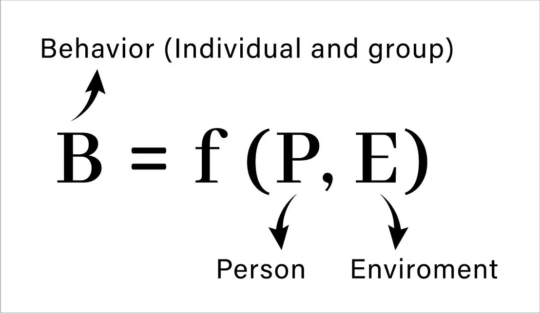To thrive in a fast-paced business environment, sales organizations need effective change management to drive fast adoption and create a culture of continuous improvement.
Kurt Lewin’s behavior formula, B=f(P,E), provides a timeless solution.

It explains how behavior (B) is influenced (f) by both personal factors (P) and the surrounding environment (E). By leveraging this formula, managers can foster high adoption rates of new practices and create a culture of continuous improvement, essential for navigating today’s ever-changing landscape.
One key area where this is particularly relevant is business visibility. Fast-paced change and uncertainty make it almost impossible to manage the sales team based on a single target. The likelihood of missing that target is 100%, either by overshooting or not reaching it. Therefore, a future proof practice is to implement scenario-based budgeting and forecasting. To work well, this requires a culture of continuous improvement and a high adoption of CRM.
Applying Lewin’s formula to drive change for High Performance
To achieve high adoption of CRM and cultivate a culture of continuous improvement, it’s essential to adapt the context within which your sales team operates. This directly ties into Lewin’s formula, where changing the environment (E) can significantly influence behavior (B). The first step is to increase the value of the CRM to meet the day-to-day needs of the sales team. Too often, CRM systems are seen as overly complex, with fields and workflows that don’t align with the salespeople’s reality. This misalignment leads to the CRM being viewed as a burdensome reporting tool rather than a valuable resource.
Tailoring CRM to Sales Reality
For a CRM system to be genuinely useful, it must be designed to allow salespeople to reflect their reality instead of asking them to report what you would like to see. Giving management a view of the perceived reality by sales allows for active steering and coaching instead of showing a not up to date ‘virtual’ reality. This includes simplifying fields, agile workflows to reflect the buying process based on customer verifiable outcomes. Providing dashboards allowing sales to optimize their time spend and ensuring that CRM adds tangible value to their daily tasks is another key factor. When salespeople see the CRM as a tool that helps them close deals and manage relationships more effectively, rather than just a reporting obligation, their adoption and engagement will naturally increase.
Leadership by Example
A critical factor in driving change is leadership behavior. Sales leaders must walk the talk by using the CRM themselves, conducting one-on-one business reviews based on live CRM, and leveraging BI dashboards. When leaders use the CRM in their daily operations, decision-making, and steering & coaching, it sets a powerful example for the rest of the team. This alignment of personal factors (P) and environment (E) reinforces the desired behavior (B). It signals that the CRM is not just for reporting but is a crucial tool for sales strategy and operational effectiveness.

Building a Culture of Continuous Improvement
In today’s dynamic market, fostering a culture of continuous improvement is vital. This culture hinges on experience sharing and learning from one another. Regular team meetings should not only focus on sharing successes and challenges but also involve using the collective intelligence of the team to come up with practical suggestions to help solve the challenges at hand. Encouraging open communication and collaboration helps the team adapt quickly to new strategies and market conditions. Thus, improving both personal motivation (P) and the working environment (E).
Scenario-Based Budgeting and Forecasting
Simplifying the CRM system and increasing the perceived value to the sales team paves the way for implementing scenario-based forecasting. This approach involves creating three scenarios: worst case, most realistic case, and best case. This approach directly applies Lewin’s formula by aligning personal efforts (P) with an adaptive environment (E)
This method allows for more effective steering, coaching and self-coaching since the differences between scenarios should be minimal in the short term and vary more for future projections. Scenarios are typically generated by correlating a few key fields and checkboxes, which can be automated. This strategic and agile approach enables sales teams to see the direct impact of their efforts and adjust their strategies accordingly, reinforcing the importance of accurate data based on customer verifiable outcomes.
Conclusion
Kurt Lewin’s formula offers timeless wisdom for managing change in sales organizations. By recognizing that behavior is influenced by both personal motivations and the broader environment, leaders can craft strategies that drive real, sustainable change. As Lewin’s insights have proven, merely delivering training and coaching or providing advice are necessary activities, but they are not complete solutions on their own.
Leverage Lewin’s principles to drive positive change in your sales organization. Walk the talk, create a supportive environment, use collective intelligence with intervision techniques, and build a culture of continuous improvement as a result. By doing so, you’ll not only cultivate a culture of excellence that benefits everyone but also greatly improve proactive behavior and increase your business visibility and results.
At Perpetos, we implement change by integrating technology improvements with training, coaching, mentoring, and consulting. Our hands-on, pragmatic approach is delivered through implementation services by our co-pilots. This method adapts the context within which your team operates, fostering a culture of continuous improvement and leading by example. Our comprehensive solutions help leaders guide their teams through today’s complexities, ensuring not just survival but also maximizing potential. Let’s navigate change together and build future-proof organizations.
This approach adapts the context within which your team operates and fosters a culture of continuous improvement and leading by example. Our comprehensive solutions help leaders guide their teams through today’s complexities, ensuring not just stability, but maximizing potential. Let’s navigate change together and build future proof organizations.
Contact us if you’re ready for commercial excellence!



 Pascal Persyn
Pascal Persyn